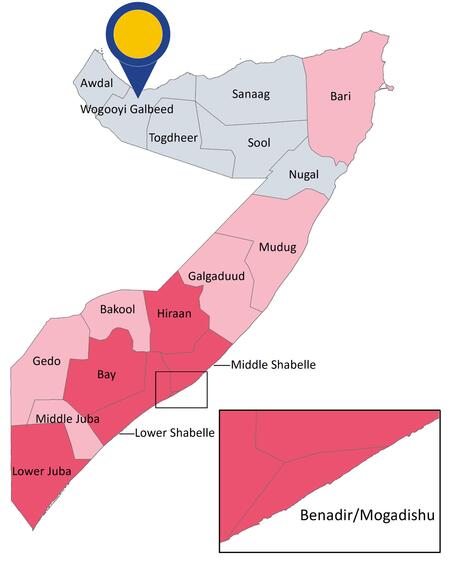COMMON ANALYSIS
Last updated: June 2022
The situation in Wogoyi Galbeed should be seen in light of the situation in the neighbouring regions of Awdal and Togdheer.

General information about the region
Wogoyi Galbeed region consists of three districts and its capital is Hargeisa. Hargeisa is also the capital of Somaliland.
Hargeisa has become the biggest urban setting in Somaliland, has been almost entirely rebuilt, and has expanded rapidly in both size and density [Socio-economic 2021, 3.1].
Wogooy Galbeed is predominantly inhabited by the Habar Awal clan. The other two main clans in the region are Habar Yunis and Idagalle. As to the state capital, Hargeisa, its neighbourhoods are strongly clan related, with the town territory partitioned among the various clans and sub-clans present in town: mainly Habar Awal, Habar Yonis, Habar Jeelo, Idagalle, but also minority groups.
In 2014, UNFPA and Somali authorities estimated the population of Wogoyi Galbeed region at 1 242 003 inhabitants.
Background and actors involved in armed confrontations
Somaliland forces control most of Somaliland territory (middle and western part).
Al-Shabaab maintains a quiet network in Somaliland, mainly for purposes of finances and recruitment.
A combination of informal and formal intelligence gathering capabilities and networks by the Somaliland authorities, have been described as keys to their success against Al-Shabaab, so far.
Furthermore, the presence of clan militias in Wogoyi Galbeed region has been reported.
Nature of violence
Armed clashes between clan militias have been reported. For example, in July 2020, an armed clash between two sub-clans caused two fatalities and six injuries, in connection with a land dispute and ongoing clan revenge.
Among others, security incidents related to clan conflicts do not always receive local media attention and hence might go under-reported in Somalia.
On December 2020, two boys were killed after an unexploded ordnance detonated on the outskirts of Berbera town.
Incidents data
ACLED recorded 5 security incidents (an average of 0.1 security incidents per week) in Wogoyi Galbeed region between 1 January 2020 and 30 June 2021. Out of those incidents, 1 was coded as battle, 1 as explosion/remote violence and 3 as violence against civilians.
Geographical scope
Security incidents occurred in 2 out of 3 districts of Wogoyi Galbeed region with the largest overall number being recorded in Hargeisa district (3 incidents).
Fatalities among civilians and non-civilians
In the reference period, ACLED recorded a total of 9 fatalities in the region. Compared to the figures for the population in the region as from 2014, this represents approximately 1 fatality per 100 000 inhabitants.
Displacement
Between January 2020 and May 2021, PRMN reported 2 700 new displacements from Wogoyi Galbeed, mostly to Mudug. In this period, conflict and insecurity led to the displacement of 4 cases. In 2020 and until May 2021, additional 2 230 displacements to Woqooyi Galbeed were registered from other Somaliland or neighbouring regions.
Further impact of the armed conflict(s) on the life of civilians
The presence of entry and exit checkpoints at each district within Somaliland has been reported. There are also checkpoints on all the roads leading in and out of the Hargeisa city, even though not affecting the accessibility or mobility of residents [Socio-economic 2021, 3.2.2.1].
Hargeisa city attracts a large number of refugees, returnees and IDPs [Socio-economic 2021, 3.1].
In 2020, Somaliland authorities issued directives imposing conditions on humanitarian aid organizations, thereby potentially hampering humanitarian operations. For the Woqooyi Galbeed region, 14 incidents of humanitarian workers being unable to access sites were reported in 2020.
Gang rape and other forms of gender-based violence were reported to remain a problem in urban areas of Somaliland, often occurring in impoverished neighbourhoods and among immigrants, returnees and IDPs.
|
|
Looking at the indicators, it can be concluded that in the region of Wogoyi Galbeed there is, in general, no real risk for a civilian to be personally affected within the meaning of Article 15(c) QD. |
